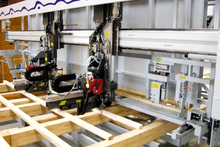Dec 6, 2014
House-building plant planned for Auckland

Auckland’s first house-building factory is being planned for Pokeno and could produce components for two-and-a-half houses a day.
Mike Greer, founder and chief of house building business Mike Greer Homes, said he and a joint venture partner planned to develop a $16 million high-volume residential panels factory at Pokeno because he thinks that is the best place to supply Auckland, Tauranga and Hamilton.
The factory could eventually make components for 1250 houses a year, Greer said.
“You stick timber in one end and out pops a house. We can build two-and-a-half houses a day.”
His business has formed Concision, a joint venture with construction business Spanbuild, to develop the new $14 million Rolleston factory south of Christchurch in the iZone industrial park where Weinmann specialist German machinery is installed for the production line house panel manufacturer.
Chris Aiken, chief executive of the Hobsonville Land Company – developing about 3500 residences at Hobsonville Pt – welcomed Greer’s plans.
“I think that model has legs, definitely. You can simplify and standardise house building in Auckland. These places don’t all have to look the same but a lot of them will have a bit the same to get the economies of scale,” Aiken said.
“One of the problems with my industry is we often overthink what’s really good for the customer.”
He recommended a more standardised housing model to get efficiencies of scale.
Aiken asked why New Zealanders didn’t mind buying cars that looked the same yet baulked at applying that thinking to houses.
Greer predicted the factory south of Auckland could begin production in the next two years.
“It takes an extended period of time to ramp up these factories to their maximum capacity but the size of the factory would be able to build about 1250 houses annually,” said the Christchurch-headquartered former chippie.
Greer said panels would be made at the Auckland factory to supply new houses on the city’s extremities at Silverdale, Orewa, Riverhead and Hobsonville.
“Those areas are picked because that’s where we are currently operating in the Auckland market and we have links with developers. But there’s no reason why we can’t use the product anywhere else,” he said.
Greer said Mike Greer Homes built about 800 residences annually “and we’re steadily moving towards 1000. We’re not a group home builder. I own everything I do”.
Pamela Bell, chief executive of construction industry association PrefabNZ, praised Greer’s scheme.
“It’s a well-researched and thought-out endeavour and a huge amount of investment has gone into this Christchurch factory. I think it’s a great idea to have an Auckland factory. When we look at systems in northern Europe like Sweden, traditional construction is panelised and that’s a great example of what’s possible here. It means removing the weather issues which cause time delays,” Bell said.
“We need to provide sites with more fully finished components and panels and as far as the consumer is concerned, they know their house is going to be watertight within days rather than months, decreasing the time involved in building a house and increasing quality.”
